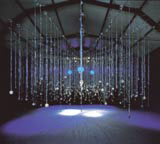Gothic user interface
Gateshead’s Baltic gallery is host to the disquieting work of artist Susan Hiller. Oliver Bennett experiences the mixed-media retrospective

Despite Newcastle-Gateshead’s unsuccessful bid to be City of Culture 2008, the Gateshead-sur-Tyne area is poised to be one of the nation’s hottest culture-leisure zones. The glittering millennial duo of Wilkinson Eyre’s parabolic bridge and the Baltic Centre for Contemporary Art have now been joined on the skyline by Lord Foster’s £70m Sage music centre, due to open at the end of the year, which is already being compared locally to a silver slug.
Gateshead’s riverside has also been enhanced by pricey housing developments – the way of the regeneration zone. But even this makes the district seem less windswept and a lot more complete, and thus it’s worth another look at the Baltic, now two years since the Williams Ellis-refurbished grain silo opened as Newcastle-Gateshead’s own culture-tourism mega-gallery. It still looks good, and is a great museum-as-event: indeed, as with Tate Modern, people visit just for the glass lifts and the view down the Tyne; still one of Britain’s great urb-scapes. And it’s got a great shop and café.
Is the art programme delivering? Some felt the launch director Sune Nordgren’s remit was too narrow and puritanical, delivering art primarily for the art world, rather than the public, and much is expected of new director Stephen Snoddy. Yet the latest show, a retrospective of artist Susan Hiller, while deeply embedded in the cerebral dialogues of contemporary art, has a certain elan. It also has the benefit of being presented in many different media: a fact that should aid its crossover appeal.
Born in 1940 in the US, but resident in the UK for many years, Hiller studied anthropology as well as art. Her work is steeped in the ‘collective unconscious’, to use Sigmund Freud’s key phrase.
For instance, on the ground floor is a sinister video installation of Punch and Judy, where Hiller repositions the kid’s puppet show as a carnival of wife-beating, infanticidal scariness. It’s the gothic underbelly of the end-of-the-pier show, enhanced with maniacal cries from the vile Mr Punch. I laughed out loud.
Upstairs, Hiller’s under-the-surface vision continues. I particularly liked her From the Freud Museum exhibit, a collection of miscellaneous items boxed up and displayed: there’s an old Waddington’s Ouija Board, a lollipop celebrating Charles and Di’s wedding, a wooden hand used in seances and a dowsing pendulum – it’s a kind of occult cabinet of curiosities and takes further the avant-garde tradition of the ‘found object’. Then there is interactive installation Dream Screens: click an iMac and a voiced soundtrack talks about dreams while you gaze at different colours on blank screens; an idea which draws from an earlier piece, also shown here, in which Hiller took a bunch of friends to camp together in Hampshire and record their dreams in exercise books.
This idea of teasing out hidden mental depths informs the whole show: other exhibits include framed pieces of automatic writing, a video installation using parts of spooky films including Carrie, and the installation Witness, where lots of little speakers dangle from the ceiling, each recounting a UFO experience in a disembodied voice.
But the real showcase lies at the top, in the Baltic’s keynote Level 4 space (the Baltic response to Tate Modern’s Turbine Hall, and the nave of Newcastle-Gateshead’s art cathedral) where Hiller has made a new sound installation where viewers pass around the room, setting off scripted accounts of near-death experiences from speakers buried in piers. Dreams, death, unseen and psychic forces – these are the things that appear to move Hiller, and when it comes off, it’s intense stuff.
Recall: Selected Works, 1969-2004 is at Baltic Centre for Contemporary Art, South Shore Road, Gateshead NE8 3BA. Telephone 0191 478 1810 or visit www.balticmill.com
-
Post a comment




